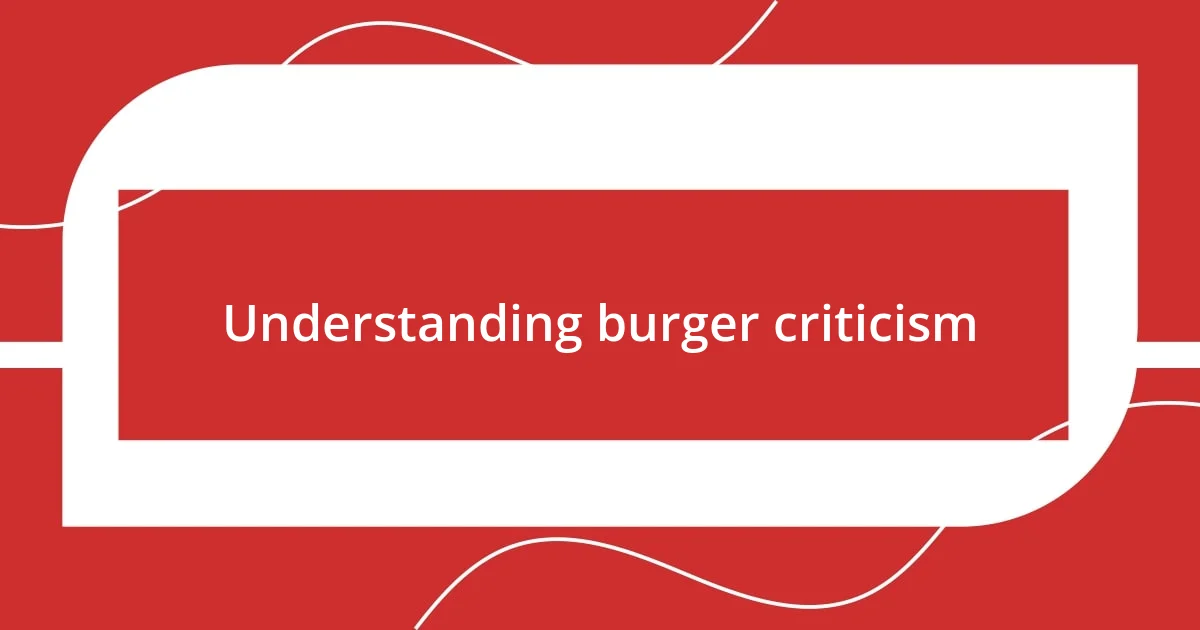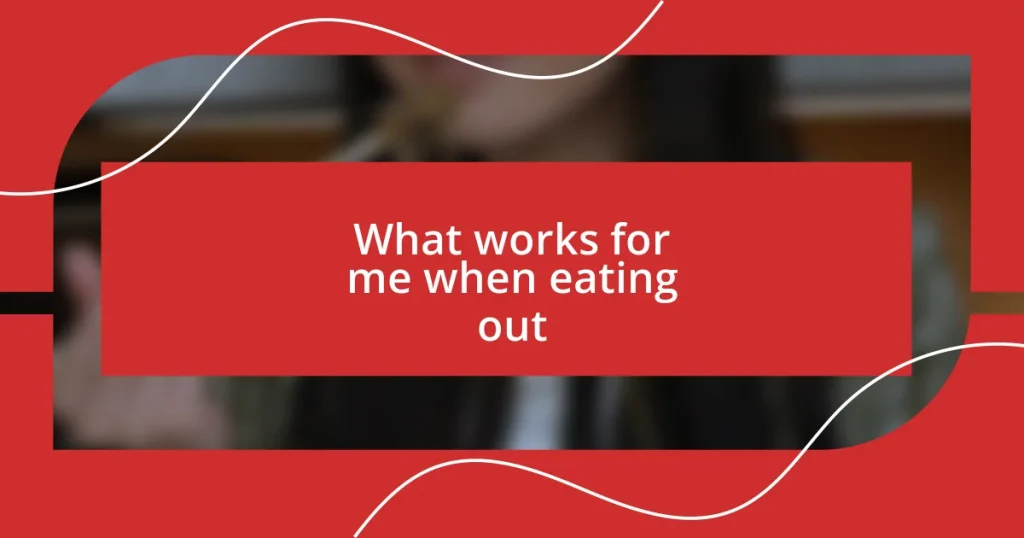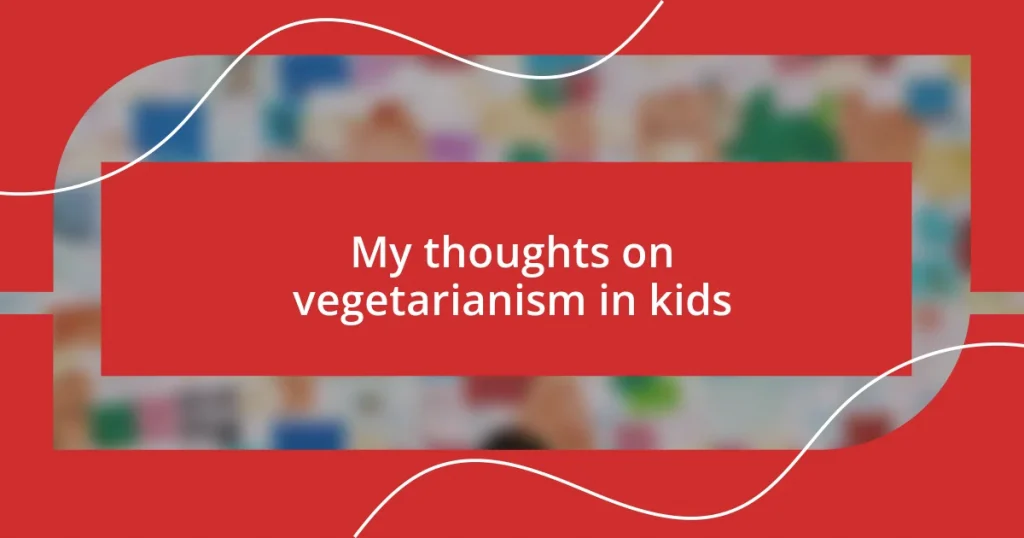Key takeaways:
- Understanding that burger criticism reflects personal tastes and experiences, which can lead to growth and culinary exploration.
- Engaging with feedback proactively and treating it as an opportunity to enhance recipes and connect with diners.
- Building a positive reputation through consistency, authenticity, and storytelling, fostering customer loyalty and involvement in the culinary journey.

Understanding burger criticism
When it comes to burger criticism, it’s essential to understand that every opinion stems from personal experiences and tastes. I remember a time when a friend, an ardent foodie, called my homemade burger “dry and flavorless.” At first, I was defensive, but that moment opened my eyes to the reality that flavors can be subjective, and what might be delectable to one could be disappointing to another.
Critiques can hit hard, especially when we invest so much in crafting the perfect burger. Have you ever spent hours perfecting a recipe, only to hear feedback that stings? I can relate to that feeling—one time, after perfecting my garlic aioli only for it to be deemed “too garlicky” by a guest. I realized then that sometimes, the emotional investment in our creations can cloud our perception of feedback.
Understanding this dynamic is crucial. Burger criticism isn’t merely about the food; it often reflects cultural backgrounds, personal passions, and culinary expectations. I often ask myself, what could their reaction teach me about flavors and preferences? Embracing that perspective has transformed how I approach feedback, allowing me to see it not as an attack, but as an opportunity for growth and deeper culinary exploration.

Common types of burger criticism
When diving into burger criticism, I often encounter a few common themes that echo across the vast landscape of culinary opinions. These critiques can reveal a lot about a person’s adventurousness or even their nostalgia for classic flavors. For instance, I once had a guest criticize my attempt at a spicy chipotle burger, saying it overshadowed the beef’s natural flavor. It made me think about how some diners prefer simplicity, craving that straightforward burger experience over creative spins.
Here are some frequent types of burger criticism I’ve experienced:
- Texture Issues: Comments about the bun being too soggy or too hard can be quite common. I once had someone say my toasted brioche bun made the burger feel more like dessert than dinner.
- Flavor Balance: Critics often mention an imbalance between various elements, like too much seasoning or an overpowering sauce. I vividly remember serving a teriyaki burger that had a sauce so sweet, a friend compared it to dessert!
- Presentation Dislike: Sometimes, despite the flavors being spot on, the visual appeal doesn’t meet expectations. I once had a beautifully stacked burger criticized for “looking like a mess” on the plate.
- Too Unique Ingredients: Those adventurous ingredients, while exciting for some, can be off-putting to traditionalists. I learned this when my truffle-infused burger drew mixed reviews; some loved it, while others simply didn’t get it.
Through these experiences, I’ve realized that every bite and critique is an opportunity to refine my take on burgers, helping me to balance creative exploration with the comfort of tradition.

Analyzing feedback effectively
When I receive feedback, I make it a point to dissect the comments carefully. I remember a moment when a friend said my burger was “overly seasoned,” which initially stung. However, I took a step back and reflected on his tastes, realizing that my adventurous seasoning choices might not align with someone who prefers a more straightforward flavor profile. Understanding this distinction helped me to approach feedback as an invitation to fine-tune my craft, rather than a personal indictment.
Analyzing feedback should also involve looking for patterns in critiques. For instance, I recall hearing multiple diners mention a lack of crunch in my burgers. Instead of brushing it off, I took it to heart and experimented with adding crispy onions or lettuce. This process taught me that trends in feedback usually hold a grain of truth—these repeated suggestions can guide you in enhancing your dishes more effectively.
To make sense of feedback, I like to compare the overall experience of enjoyment versus criticism. I keep a mental note of not only the negative comments but also the praise. It’s fascinating how, during one dinner party, a burger received rave reviews for its juiciness, while someone else bemoaned the “missing zing.” By analyzing such contrasts, I’ve learned to appreciate what works and to identify areas that may need adjustments to cater to a broader audience.
| Feedback Type | Response Strategy |
|---|---|
| Overly Seasoned | Experiment with less intense flavors |
| Lack of Crunch | Add crispy toppings to enhance texture |
| Missing Zing | Incorporate elements to elevate brightness |

Responding to negative reviews
When I encounter negative reviews, my instinct is to see them as a chance to connect with my diners rather than simply brush them off. One time, a customer commented that my bacon cheeseburger was “too greasy.” At first, I felt a bit defensive, but then I reflected on my cooking process. I realized that not everyone has the same palate, and some people might prefer a leaner option. This insight pushed me to tweak the recipe slightly, introducing techniques that retain flavor while reducing grease.
Engagement is vital. I remember when a diner expressed disappointment with the way my BBQ burger was assembled, saying it looked “sloppy.” I took that feedback to heart and decided to invite the guest back for a taste test of a new presentation style I created. I offered a more structured approach while maintaining the essence of flavor they’d initially enjoyed. It turned into a delightful conversation about presentation versus taste, transforming a negative comment into a collaborative moment.
Now, I often wonder: how should I respond to every piece of feedback? I find that acknowledging the review is key. Whether it’s a simple, heartfelt “thank you for your honesty” or inviting them to share further thoughts, showing appreciation can turn a critique into a constructive dialogue. After all, who knows? That diner might return, more excited about a revamped burger than ever before, turning their experience into a positive story they want to share.

Improving burger recipes
I’ve always believed that tweaking a burger recipe isn’t just about altering ingredients; it’s about crafting an experience. One evening, a friend suggested adding a hint of acidity to my classic cheeseburger. Intrigued, I experimented by incorporating pickled jalapeños, and the result was a delightful balance of heat and tang. It made me realize how a simple addition can elevate a dish from good to memorable.
Texture is another aspect that often gets overlooked. One time, I decided to make a more gourmet-style burger and topped it with a homemade garlic aioli. While the flavors were spot on, I noticed the burger lacked a satisfying crunch. By experimenting with crushed potato chips as a topping, I introduced a playful contrast that made each bite more enjoyable. Have you ever wondered how little adjustments can transform a familiar dish into something extraordinary?
I also like to play around with meat blends. After a few guests remarked that my beef burgers felt a bit too heavy, I experimented by mixing in turkey and some finely minced mushrooms. The outcome was a lighter, more flavorful burger that surprised everyone at my next gathering. This entire process has taught me that improvement is a journey—one that thrives on creativity and open-mindedness. It’s not just about meeting standards; it’s about exceeding them and creating something that people will remember and crave.

Engaging with your audience
Engaging with my audience goes beyond just responding to reviews; it’s about inviting them into the culinary journey. I truly treasure those moments when diners share their thoughts. For instance, after a food festival, a young customer excitedly told me how my spicy chipotle burger reminded him of family barbecues. That connection was so rewarding; it motivated me to create a special limited-time burger in his honor. How can we, as creators, not find joy in such exchanges?
I’ve also found that social media can be a remarkable platform for engagement. One weekend, I posed a question about people’s favorite burger toppings. The flood of responses not only sparked an interesting dialogue but inspired me to experiment. One suggestion was for avocado, and I couldn’t help but think, how had I overlooked such a classic pairing? This interaction opened doors for a special promotion, allowing me to experiment with flavors while connecting with my community.
I’ve realized the power of storytelling as a tool for engagement. After crafting a new vegan burger, I shared its background—how it was inspired by my own desire for healthier options. Readers responded with enthusiasm and curiosity. This made me wonder: how often do we share the stories behind our creations? When customers understand the passion and intention behind a dish, they become invested, turning a meal into a shared experience that goes far beyond the plate.

Building a positive burger reputation
Building a positive reputation in the burger world hinges on consistency and authenticity. I once had a regular who remarked that my classic burger tasted different one week. It turned out a minor ingredient switch had altered its signature flavor. That moment pushed me to perfect my recipe and ensure every burger served was exactly what my customers craved. How often do we realize that small details can make or break trust?
Moreover, I’ve learned the importance of gathering feedback proactively. There was a time when I set up a tasting event, specifically inviting local burger enthusiasts to share their thoughts. The diverse opinions sparked some invaluable ideas. One guest suggested a unique herb blend, turning my attention to flavor profiles I hadn’t considered. This experience reinforced my belief that customers want to be part of the process—what better way to build a positive reputation than by involving them directly in the creation?
Lastly, consistency in how I communicate with my customers has been essential. When I introduced a new seasonal burger last summer, I crafted a campaign around it, sharing my excitement and the inspiration behind it. The moment people engage with the story, they feel a connection. This connection ignites loyalty—because, after all, isn’t it the stories behind our burgers that resonate with people and keep them coming back for more?















